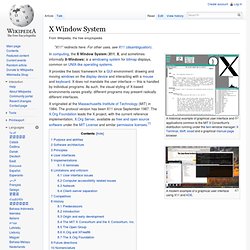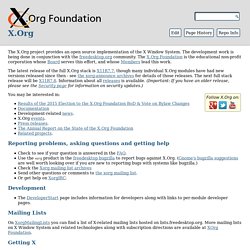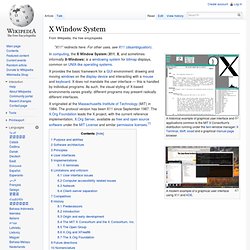

The Official FVWM Home Page. Comparison of X window managers. Comparison of X Window System desktop environments. A desktop environment is a collection of software designed to give functionality and a certain look and feel to an operating system.

Technical elements of a desktop environment[edit] A desktop environment (DE) can be broken up into several components that function independently and interact with one another to provide the look and feel and functionality of the desktop environment. A fundamental part of a DE is the window manager or WM. A window manager creates a certain way for application windows to present themselves to the user. It manages the various application windows, keeping track of which ones are open and providing features to switch between them. There are some exceptions: Window managers like Fluxbox, wmii and Ratpoison operate independently of a desktop environment and were written with this objective in mind. KDE file manager Dolphin running under GNOME Notably, nothing prevents the user from installing any number of software libraries of his/her choice. See also[edit] Xorg/proto/randrproto - X Resize and Rotate protocol headers. X Window System.
A historical example of graphical user interface and applications common to the MIT X Consortium's distribution running under the twm window manager: X Terminal, Xbiff, xload and a graphical manual page browser A modern example of a graphical user interface using X11 and KDE.

In computing, the X Window System (X11, X, and sometimes informally X-Windows) is a windowing system for bitmap displays, common on UNIX-like operating systems. X originated at the Massachusetts Institute of Technology (MIT) in 1984. The protocol version has been X11 since September 1987. The X.Org Foundation leads the X project, with the current reference implementation, X.Org Server, available as free and open source software under the MIT License and similar permissive licenses.[1] Purpose and abilities[edit] X is an architecture-independent system for remote graphical user interfaces and input device capabilities.
Software architecture[edit] Practical examples of remote clients include: Principles[edit] XFree86® Home to the X Window System. X.org - Wiki. The X.Org project provides an open source implementation of the X Window System.

The development work is being done in conjunction with the freedesktop.org community. The X.Org Foundation is the educational non-profit corporation whose Board serves this effort, and whose Members lead this work. The latest release of the full X.Org stack is X11R7.7, though many individual X.Org modules have had new versions released since then - see the xorg-announce archives for details of those releases. The next full stack release will be X11R7.8. Information about all releases is available. You may be interested in: Reporting problems, asking questions and getting help Check to see if your question is answered in the FAQ. Development The DeveloperStart page includes information for developers along with links to per-module developer pages. Mailing Lists. XQuartz. Intro ¶ The XQuartz project is an open-source effort to develop a version of the X.org X Window System that runs on OS X. Together with supporting libraries and applications, it forms the X11.app that Apple has shipped with OS X since version 10.5.
Latest Releases ¶ Mavericks users, please use 2.7.5 or later. X Window System. A historical example of graphical user interface and applications common to the MIT X Consortium's distribution running under the twm window manager: X Terminal, Xbiff, xload and a graphical manual page browser A modern example of a graphical user interface using X11 and KDE.

In computing, the X Window System (X11, X, and sometimes informally X-Windows) is a windowing system for bitmap displays, common on UNIX-like operating systems. Window Managers for X: Metacity. License: GPL Activity Rating: High Metacity is a lightweight window manager written by Havoc Pennington from Red Hat. The first version was 2.3, which was released in 2001.
It is implemented with the GTK+ 2.x toolkit, and so integrates well with the GNOME 2.x platform. In fact the intention is to remove the traditional separation between window manager and desktop, and present to the user a single desktop interface. This means that the limited configuration options available for Metacity are shown as desktop options, not as Metacity options (although there is an optional "Metacity-setup" panel which conflicts with this approach). Instead of adding numerous features, Metacity attempts to use good defaults. Here are some screenshots of Metacity: From trollet@skynet.be, added in April 2003: This 1600x1200 screenshot (358k) is from an Ultra 10 running Solaris. For downloads, themes, and further information see the following sites: